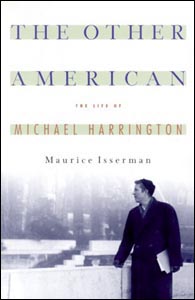![[Metroactive Books]](/books/gifs/books468.gif)
[ Books Index | San Jose | Metroactive Central | Archives ]
Socialist Superstar
A new biography looks back at the life of one of America's great political activists
By Ralph Seliger
IN JUNE 1988, during a lull in the cancer that ended his life a year later, Michael Harrington was honored at a gala 60th birthday celebration by 600 paying guests at New York's Roseland Ballroom. The speakers included Gloria Steinem, Cesar Chavez and Ted Kennedy. (Twenty years earlier, almost to the day, Harrington served as a Bobby Kennedy delegate to the 1968 Democratic Convention and sat next to Daniel Patrick Moynihan on the funeral train that bore the slain candidate's body.)
Harrington was the third and last great American socialist leader of the 20th century, but unlike the first two--Eugene Victor Debs and Norman Thomas, both of whom won a million votes in presidential elections--he had no mass following. He was a hero of mine when I was a college student, and I can personally attest to his persuasiveness and charm as a speaker--and also to his astonishingly fluid and prolific output as a writer. Most of this review recounts his remarkable life as related by Maurice Isserman in his biography of Harrington, The Other American, supplemented with some observations and minor dissents of my own.
Harrington may be the only publicly identified socialist to have actually influenced government policy in this country. The first of his 14 books, The Other America, a study of American poverty, thrust him into national prominence in 1962. Yet even in being appointed to the initial planning panel for Lyndon Johnson's War on Poverty, he was effectively sandbagged by more conservative thinking.
In this well-researched and beautifully written work, Isserman traces Harrington's life journey from a middle-class Irish Catholic home in suburban St. Louis, through his youthful enthusiasms, including several years in the early 1950s as an impoverished activist and newspaper editor for the passionately pacifist Catholic Worker movement of Dorothy Day.
Harrington then embraced Marxism and left the Catholic Church. He became a stalwart of the former Trotsky protégé Max Shachtman, who founded the "Third Camp" radical tradition, which equally opposed both the capitalist West and the Sino-Soviet bloc. By the late '50s, after having been bitter rivals, Norman Thomas' Socialist Party absorbed the smaller but much more dynamic Shachtmanite group. Key Shachtmanites, including Harrington, eventually rose to lead the Socialist Party, but Harrington personally gravitated toward the more moderate Thomas and away from Shachtman.
After Harrington became chairman of the Socialist-allied League for Industrial Democracy in 1964, the latter's youth division adopted a new name: Students for a Democratic Society (SDS). Harrington battled with the early SDS over its relative lack of anti-Communist conviction, but later apologized repeatedly for having overreacted. Within five short years, SDS blew itself apart between Weatherman bomb-throwers and far-out Maoist crazies. Harrington's concern that young radicals understand the dangers of anti-democratic movements on the left seems in retrospect to have been perfectly legitimate, but Isserman fails to make this point.
It was the ever-worsening war in Vietnam that more than anything else drove SDS toward extremism. Eventually, the war was to claim the Socialist Party as its victim as well. Harrington evolved, with most of the liberal left, from discomfort to all-out opposition to a war that was, after all, the product of a liberal Democratic administration. The Shachtmanite majority of the Socialist Party actually supported the war, basically because most of organized labor supported the war.
Harrington broke with his former comrades, and in 1973 formed and led a new organization called the Democratic Socialist Organizing Committee. The author sees DSOC's high-water mark as the 1978 midterm Democratic Party Convention when Harrington was a leader of those battling President Carter's relatively conservative economic policies. He notes that Hillary Rodham Clinton was a floor leader of the pro-Carter forces at that convention.
ISSERMAN IS very sympathetic to his subject, but indicates that Harrington had difficulty with the "identity politics" that so occupied the left in the '70s and '80s. Isserman mildly criticizes him in this connection as too much of a "Marxist." To me, however, Harrington's emphasis on the overarching economic issues that might appeal to a majority coalition--while also not ignoring the social concerns of race/ethnicity, feminism, sexual orientation, disability and the like--was right on target.
Still, Harrington's hopes crashed and burned in the 1980s with the repeat victories of Reagan and Bush. As if seeking solace, Harrington often turned to meetings of the Socialist International, the organized framework that links labor and social democratic parties around the world. He was frequently the honored guest of social democratic prime ministers and presidents, such as Sweden's Olaf Palme and France's Francois Mitterand.
Harrington succumbed to cancer on July 31, 1989, just as the Soviet empire began to collapse. Had he lived, it would have disturbed him profoundly that the major beneficiary of the victory over Stalinism has not been democratic socialism or social democracy, but rather a buccaneering species of global capitalism.
[ San Jose | Metroactive Central | Archives ]
Copyright © 2000 Metro Publishing Inc. Metroactive is affiliated with the Boulevards Network.
For more information about the San Jose/Silicon Valley area, visit sanjose.com.
![]()

The Other American: The Life of Michael Harrington
By Maurice Isserman;
Public Affairs; 431 pages; $28.50 cloth
Ralph Seliger freelances from New York, where he knew and admired Michael Harrington back in the early 1970s.
From the August 17-23, 2000 issue of Metro, Silicon Valley's Weekly Newspaper.